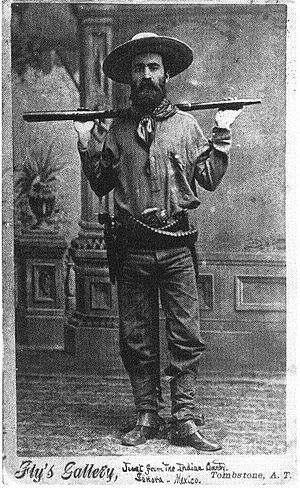George W. Parsons facts for kids
Quick facts for kids
George Whitwell Parsons
|
|
|---|---|

George W. Parsons
|
|
| Born | August 26, 1850 |
| Died | January 5, 1933 (aged 82) |
| Occupation | Attorney, banker |
| Known for | His detailed diary of life in the era of Virgil and Wyatt Earp |
George Whitwell Parsons (born August 26, 1850 – died January 5, 1933) was a banker who lived during the exciting time of the Old West in the 1800s. He is famous for keeping a very detailed daily diary. This diary tells us a lot about his life, especially when he lived in Tombstone, Arizona Territory from 1879 to 1887. His writings describe what life was like in Tombstone and his meetings with people who later became well-known, such as Wyatt Earp and Ike Clanton.
Contents
Early Life and New Beginnings
George Parsons was born in Washington, D.C.. He was expected to become a lawyer, like his father. However, he didn't enjoy law. Around 1874, he started a different job in Florida. He became a salvager, which meant he helped save things from shipwrecks.
One day, while working near Cape Sable, he almost died during a big hurricane. This scary experience made Parsons decide to find a new career. In 1876, he moved to California. For three years, he worked as a bank clerk in Los Angeles. Later, he worked for another bank, but it closed in 1880, leaving him without a job.
His Amazing Diary
Parsons started writing in his diary in 1869. This was after his mother passed away, which was a very sad event for him. He remembered her every year on the anniversary of her death in his diary.
He wrote in his diary every single day for sixty years! His entries cover the years from 1869 to 1929. Because he wrote so much detail, his diary is a very important source of information for people who study history.
Life in Tombstone, Arizona
George Parsons moved to Tombstone, Arizona, with his friend Milton Clapp. Tombstone was a "boomtown," meaning it grew very quickly because of mining. At first, Parsons worked in the mines. Later, he became a mining agent with a partner named J. L. Redfern.
He became friends with John Clum, who was the mayor of Tombstone and also the editor of the local newspaper, The Tombstone Epitaph.
Parsons's Role in the Community
The events Parsons saw in Tombstone make his diaries very interesting for historians. He joined a group called the "Committee of Vigilance." This group helped keep order in the town. Parsons was even on its main leadership team, called the "Council of Ten."
He was good friends with lawmen like Wyatt Earp and John Clum. He also knew other important people in law enforcement, such as Fred White, Virgil Earp, Johnny Behan, and Morgan Earp. Parsons also met people who were known for breaking the law, like Ike Clanton, "Curly Bill" Brocius, and Johnny Ringo.
For seven years, Parsons wrote daily about his life. He carefully recorded what happened before, during, and after the famous Gunfight at the O.K. Corral. His diary gives us a special look into the people and events of that time.
A Close Call and a New Nose
In June 1881, a big fire happened in Tombstone. Parsons was helping to tear down a balcony to stop the fire from spreading when he was hit by falling wood. A piece of wood went through his upper lip and nose, badly flattening and changing his nose.
Dr. George E. Goodfellow helped him. The doctor used a special wire frame and did several treatments, like plastic surgery, to fix Parsons's nose. He successfully made Parsons's nose look like it did before the injury. Dr. Goodfellow refused to take any money because Parsons had been hurt while helping others.
Other Notable Events
Parsons's diary also describes other important events. He wrote about the grand opening of the Oriental Saloon, which later became famous in Old West stories. He also became friends with Reverend Endicott Peabody. When Parsons found out the Reverend was a good boxer, he arranged a boxing match between him and another minister, Joseph P. “Mac” McIntyre. Endicott won the match!
In 1885, Parsons became the first librarian for the Tombstone Library. By 1887, Tombstone was becoming less important, so Parsons decided to leave.
Later Life and Legacy
In 1887, Parsons moved to Los Angeles, California. He became a director for the Los Angeles Chamber of Commerce. He also served as the president of the Los Angeles Mining and Stock Exchange.
Parsons stopped writing in his diary in 1929. After his death, his wife, Emma Parsons, gave parts of his diary to the Arizona Pioneers Historical Society in the 1930s.
An editor named Carl Chafin spent many years studying Parsons's diary. He later published the parts that covered the years from 1879 to 1887. George Parsons passed away in Los Angeles and was buried in Evergreen Cemetery. His diaries are still published today, most notably in the book A Tenderfoot in Tombstone, the Private Journal of George Whitwell Parsons: The Turbulent Years, 1880–82, written by Lynn R. Bailey.

